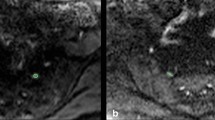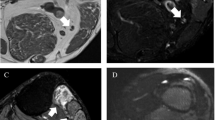Abstract
Purpose
This study compares the performance of a 4-min multi-echo in steady-state acquisition (MENSA) with a 6-min fast spin echo with variable flip angle (CUBE) protocol for the assessment of lumbosacral plexus nerve root lesions.
Methods
Seventy-two subjects underwent MENSA and CUBE sequences on a 3.0-T MRI scanner. Two musculoskeletal radiologists independently assessed the images for quality and diagnostic capability. A qualitative assessment scoring system for image quality and quantitative nerve signal-to-noise ratio (SNR) and iliac vein and muscle contrast-to-noise ratios (CNR) was applied. Using surgical reports as the reference, sensitivity, specificity, accuracy, and area under the receiver operating characteristic curves (AUC) were evaluated. Intraclass correlation coefficients (ICC) and weighted kappa were used to calculate reliability.
Results
MENSA image quality rating (3.679 ± 0.47) was higher than for CUBE images (3.038 ± 0.68), and MENSA showed higher mean nerve root SNR (36.935 ± 8.33 vs. 27.777 ± 7.41), iliac vein CNR (24.678 ± 6.63 vs. 5.210 ± 3.93), and muscle CNR (19.414 ± 6.07 vs. 13.531 ± 0.65) than CUBE (P < 0.05). Weighted kappa and ICC values indicated good reliability. Sensitivity, specificity, and accuracy of diagnosis based on MENSA images were 96.23%, 89.47%, and 94.44%, respectively, and AUC was 0.929, compared with 92.45%, 84.21%, 90.28%, and 0.883 for CUBE images. The two correlated ROC curves were not significantly different. Weighted kappa values for intraobserver (0.758) and interobserver (0.768–0.818) reliability were substantial to perfect.
Conclusion
A time-efficient 4-min MENSA protocol exhibits superior image quality and high vascular contrast with the potential to produce high-resolution lumbosacral nerve root images.



Similar content being viewed by others
Data Availability
The data that support the findings of this study are available from the corresponding author, Xiaoming Li, upon reasonable request.
Abbreviations
- 3D:
-
Three-dimensional
- TSE:
-
Turbo spin echo
- FSE:
-
Fast spin echo
- TR:
-
Repetition time
- SSFP-FID:
-
Steady-state free precession-free induction decay
- SNR:
-
Signal-to-noise ratio
- CNR:
-
Contrast-to-noise ratio
- CR:
-
Contrast ratio
- MENSA:
-
Multi-echo in steady-state acquisition
- CUBE:
-
3D fast spin echo with variable flip angle
- ROC:
-
Receiver operating characteristics
- AUC:
-
Areas under receiver operating characteristics curves
References
Tarulli AW, Raynor EM (2007) Lumbosacral radiculopathy. Neurol Clin 25:387–405. https://doi.org/10.1016/j.ncl.2007.01.008
van der Windt DA, Simons E, Riphagen, II, Ammendolia C, Verhagen AP, Laslett M et al (2010) Physical examination for lumbar radiculopathy due to disc herniation in patients with low-back pain. Cochrane Database Syst Rev:Cd007431. https://doi.org/10.1002/14651858.CD007431.pub2
Jarvik JG, Deyo RA (2002) Diagnostic evaluation of low back pain with emphasis on imaging. Ann Intern Med 137:586–597. https://doi.org/10.7326/0003-4819-137-7-200210010-00010
Al Nezari NH, Schneiders AG, Hendrick PA (2013) Neurological examination of the peripheral nervous system to diagnose lumbar spinal disc herniation with suspected radiculopathy: a systematic review and meta-analysis. Spine J 13:657–674. https://doi.org/10.1016/j.spinee.2013.02.007
Delaney H, Bencardino J, Rosenberg ZS (2014) Magnetic resonance neurography of the pelvis and lumbosacral plexus. Neuroimaging Clin N Am 24:127–150. https://doi.org/10.1016/j.nic.2013.03.026
Sollmann N, Weidlich D, Cervantes B, Klupp E, Ganter C, Kooijman H et al (2019) High isotropic resolution T2 mapping of the lumbosacral plexus with T2-prepared 3D turbo spin echo. Clin Neuroradiol 29:223–230. https://doi.org/10.1007/s00062-017-0658-9
Fernandez CE, Franz CK, Ko JH, Walter JM, Koralnik IJ, Ahlawat S et al (2021) Imaging review of peripheral nerve injuries in patients with COVID-19. Radiology 298:E117–E130. https://doi.org/10.1148/radiol.2020203116
Sung J, Jee WH, Jung JY, Jang J, Kim JS, Kim YH et al (2017) Diagnosis of nerve root compromise of the lumbar spine: evaluation of the performance of three-dimensional isotropic T2-weighted turbo spin-echo SPACE sequence at 3T. Korean J Radiol 18:249–259. https://doi.org/10.3348/kjr.2017.18.1.249
Cervantes B, Bauer JS, Zibold F, Kooijman H, Settles M, Haase A et al (2016) Imaging of the lumbar plexus: optimized refocusing flip angle train design for 3D TSE. J Magn Reson Imaging 43:789–799. https://doi.org/10.1002/jmri.25076
Chhabra A, Andreisek G, Soldatos T, Wang KC, Flammang AJ, Belzberg AJ et al (2011) MR neurography: past, present, and future. Am J Roentgenol 197:583–591. https://doi.org/10.2214/ajr.10.6012
Hossein J, Fariborz F, Mehrnaz R, Babak R (2019) Evaluation of diagnostic value and T2-weighted three-dimensional isotropic turbo spin-echo (3D-SPACE) image quality in comparison with T2-weighted two-dimensional turbo spin-echo (2D-TSE) sequences in lumbar spine MR imaging. Eur J Radiol open 6:36–41. https://doi.org/10.1016/j.ejro.2018.12.003
Chhabra A, Zhao L, Carrino JA, Trueblood E, Koceski S, Shteriev F et al (2013) MR neurography: advances. Radiol Res Pract 2013:809568. https://doi.org/10.1155/2013/809568
Kasper JM, Wadhwa V, Scott KM, Rozen S, Xi Y, Chhabra A (2015) SHINKEI—a novel 3D isotropic MR neurography technique: technical advantages over 3DIRTSE-based imaging. Eur Radiol 25:1672–1677. https://doi.org/10.1007/s00330-014-3552-8
Chen CA, Kijowski R, Shapiro LM, Tuite MJ, Davis KW, Klaers JL et al (2010) Cartilage morphology at 3.0T: assessment of three-dimensional magnetic resonance imaging techniques. J Magn Reson Imaging 32:173–183. https://doi.org/10.1002/jmri.22213
Redpath TW, Jones RA (1988) FADE–a new fast imaging sequence. Magn Reson Med 6:224–234. https://doi.org/10.1002/mrm.1910060211
Bruder H, Fischer H, Graumann R, Deimling M (1988) A new steady-state imaging sequence for simultaneous acquisition of two MR images with clearly different contrasts. Magn Reson Med 7:35–42. https://doi.org/10.1002/mrm.1910070105
Eckstein F, Hudelmaier M, Wirth W, Kiefer B, Jackson R, Yu J et al (2006) Double echo steady state magnetic resonance imaging of knee articular cartilage at 3 Tesla: a pilot study for the Osteoarthritis Initiative. Ann Rheum Dis 65:433–441. https://doi.org/10.1136/ard.2005.039370
Welvaert M, Rosseel Y (2013) On the definition of signal-to-noise ratio and contrast-to-noise ratio for fMRI data. PLoS One 8:10. https://doi.org/10.1371/journal.pone.0077089
Kong C, Li XY, Sun SY, Sun XY, Zhang M, Sun Z et al (2021) The value of contrast-enhanced three-dimensional isotropic T2-weighted turbo spin-echo SPACE sequence in the diagnosis of patients with lumbosacral nerve root compression. Eur Spine J 30:855–864. https://doi.org/10.1007/s00586-020-06600-7
Pfirrmann CW, Dora C, Schmid MR, Zanetti M, Hodler J, Boos N (2004) MR image-based grading of lumbar nerve root compromise due to disk herniation: reliability study with surgical correlation. Radiology 230:583–588. https://doi.org/10.1148/radiol.2302021289
Griffith JF, Wang YX, Antonio GE, Choi KC, Yu A, Ahuja AT et al (2007) Modified Pfirrmann grading system for lumbar intervertebral disc degeneration. Spine 32:E708-712. https://doi.org/10.1097/BRS.0b013e31815a59a0
DeLong ER, DeLong DM, Clarke-Pearson DL (1988) Comparing the areas under two or more correlated receiver operating characteristic curves: a nonparametric approach. Biometrics 44:837–845. https://doi.org/10.2307/2531595
Malpica A, Matisic JP, Niekirk DV, Crum CP, Staerkel GA, Yamal JM et al (2005) Kappa statistics to measure interrater and intrarater agreement for 1790 cervical biopsy specimens among twelve pathologists: qualitative histopathologic analysis and methodologic issues. Gynecol Oncol 99:S38-52. https://doi.org/10.1016/j.ygyno.2005.07.040
Wang L, Niu Y, Kong X, Yu Q, Kong X, Lv Y et al (2016) The application of paramagnetic contrast-based T2 effect to 3D heavily T2W high-resolution MR imaging of the brachial plexus and its branches. Eur J Radiol 85:578–584. https://doi.org/10.1016/j.ejrad.2015.12.001
Zhang Y, Kong X, Zhao Q, Liu X, Gu Y, Xu L (2020) Enhanced MR neurography of the lumbosacral plexus with robust vascular suppression and improved delineation of its small branches. Eur J Radiol 129:109128. https://doi.org/10.1016/j.ejrad.2020.109128
Soldatos T, Andreisek G, Thawait GK, Guggenberger R, Williams EH, Carrino JA et al (2013) High-resolution 3-T MR neurography of the lumbosacral plexus. Radiographics 33:967–987. https://doi.org/10.1148/rg.334115761
Funding
This study was supported by the National Natural Science Foundation of China (NSFC) (No. 81930045).
Author information
Authors and Affiliations
Corresponding authors
Ethics declarations
Conflict of interest
The authors have no relevant financial or non-financial interests to disclose.
Ethics approval
Ethical approval was waived by the Institutional Review Board of Tongji hospital.
Consent to participate
Informed consent was obtained from all individual participants included in the study.
Additional information
Publisher's note
Springer Nature remains neutral with regard to jurisdictional claims in published maps and institutional affiliations.
Rights and permissions
Springer Nature or its licensor (e.g. a society or other partner) holds exclusive rights to this article under a publishing agreement with the author(s) or other rightsholder(s); author self-archiving of the accepted manuscript version of this article is solely governed by the terms of such publishing agreement and applicable law.
About this article
Cite this article
Hu, S., Li, Y., Hou, B. et al. Multi-echo in steady-state acquisition improves MRI image quality and lumbosacral radiculopathy diagnosis efficacy compared with T2 fast spin-echo sequence. Neuroradiology 65, 969–977 (2023). https://doi.org/10.1007/s00234-023-03130-z
Received:
Accepted:
Published:
Issue Date:
DOI: https://doi.org/10.1007/s00234-023-03130-z




